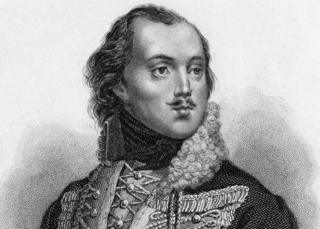 Image copyright
Image copyright
Getty Images
Casimir Pulaski fought alongside American troops against the British in 1777
The 18th Century Polish-American general Casimir Pulaski was either female or intersex, researchers say.
Pulaski, a nobleman who joined George Washington’s army and fought British troops in 1777, is considered a war hero in both Poland and the US.
Scientists first found that Pulaski’s skeleton had female characteristics about 20 years ago, but were unable to prove it was definitely him.
But DNA testing has now confirmed the female skeleton was indeed Pulaski’s.
Their findings will be set out in a Smithsonian Channel documentary, called “America’s Hidden Stories: The General Was Female?” on 8 April.
Who was Casimir Pulaski?
Pulaski was born in Warsaw in 1745 and became interested in politics from an early age.
As a teenager, he was outlawed by Russia for fighting for Polish independence, fleeing to Paris.
It was there he met the American revolutionary Benjamin Franklin, who convinced him to support the colonies fighting against England in the American Revolution.
He is believed to have saved George Washington’s life in 1777’s the Battle of Brandywine, finding an escape route through which Washington and his soldiers were able to retreat.
He died in 1779 at the age of 34, a short time after being fatally wounded during the siege of Savannah.
Pulaski’s bones had been kept in a metal container underneath a monument in Savannah, Georgia – so when the monument was temporarily removed about two decades ago, researchers were able to exhume and study his skeleton.
Charles Merbs, who was a forensic anthropologist at Arizona State University at the time, told ASU Now that he examined the bones with forensic scientist Dr Karen Burns from the University of Georgia.
“Dr Burns said to me before I went in, ‘go in and don’t come out screaming’,” he says. “She said study it very carefully and thoroughly and then let’s sit down and discuss it.
“I went in and immediately saw what she was talking about. The skeleton is about as female as can be.”
How did they confirm it was Pulaski?
After this, they had to prove that the bones did in fact belong to Pulaski and that they had not been replaced with the remains of someone else.
They first studied the skeleton’s injuries, which were consistent with horse riding and battle.
The next step, then, was to test the skeleton’s DNA.
Since the type of DNA they needed to test is passed down through women, Dr Merbs and Dr Burns tracked down the remains of Pulaski’s grandniece to see if it was a match.
But testing at the time wasn’t advanced enough, and they were not able to get any results. The bones were reburied next to the monument, and their findings were classed as “opinion”.
- Intersex surgeries: Is it right to assign sex to a baby?
- Germany adopts intersex identity into law
- The taboo of Kenya’s intersex children
The matter was forgotten until recently, when three other researchers decided to look back into the evidence and see if they could get better results with more up-to-date technology.
When they tested the bones, the match was positive – the skeleton’s DNA was “identical” to that of Pulaski’s descendant.
The UN says that up to 1.7% of the world’s population are born with intersex traits – meaning they are born with both male and female sex characteristics.
Dr Merbs says it is unlikely that Pulaski, who was raised male, ever believed he was female or intersex – just that “something was wrong”.
“Back in those days, they just didn’t know,” he adds.
Casimir Pulaski may have been woman or intersex, study says

